#Vaccinium corymbosum
Text

Bombus bimaculatus on Vaccinium corymbosum / Two-Spotted Bumblebee on Northern Highbush Blueberry
#Bombus bimaculatus#Bombus#apidae#Vaccinium corymbosum#Vaccinium#ericaceae#Two-spotted Bumblebee#Two spotted Bumblebee#Bumblebee#Bumblebees#Bee#Bees#Northern Highbush blueberry#Highbush Blueberry#Blueberry#Blueberries#Native pollinators#Native bees#Pollinators#Native plants#Native flowers#Flowers#Nature photography#photographers on tumblr#Fruit#Durham#Durham NC#North Carolina#Home
7 notes
·
View notes
Text
🍉 fruit of the week: Vaccinium corymbosum
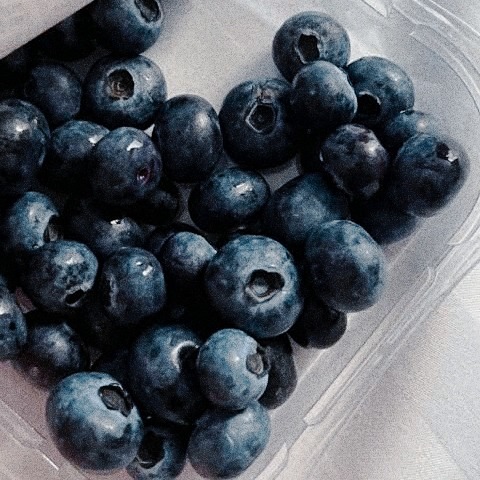
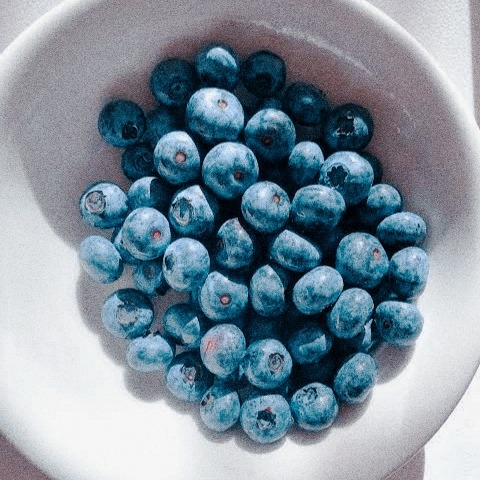
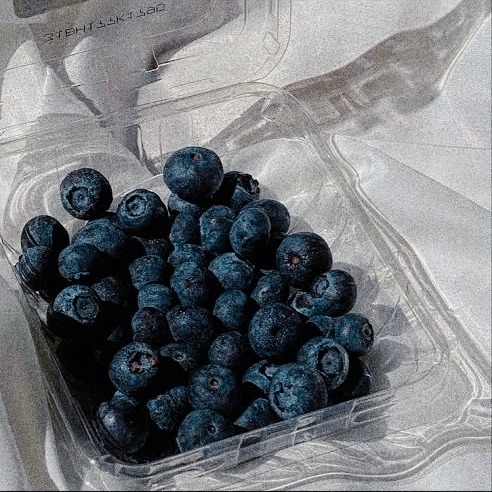
aka. northern highbush blueberry, blue huckleberry, tall huckleberry, swamp huckleberry, high blueberry, swamp blueberry. native to eastern Canada and the eastern and southern United States.
#northern highbush blueberry#blue huckleberry#tall huckleberry#swamp huckleberry#vaccinium corymbosum#vaccinium#high blueberry#swamp blueberry#blueberry#huckleberry
0 notes
Text

Arádanos azules
Foto: Melissa Belanger - Unsplash
0 notes
Photo
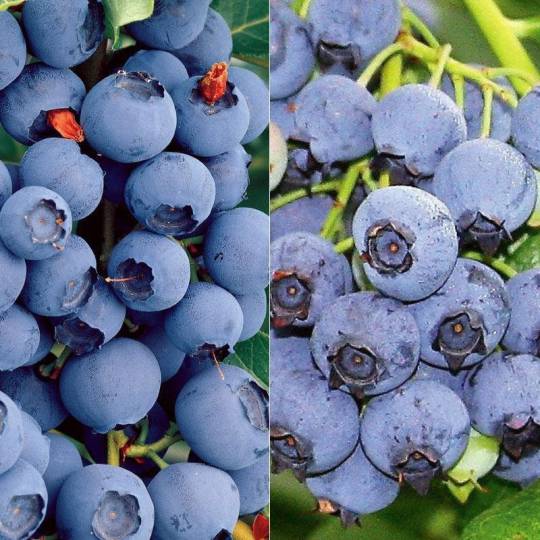
Delicious Blueberry Huge mix blend of Seeds, Organic Fruit, Ornamental, Superfood, Antioxidant B25 Nothing Tastes Better Than Fresh Blueberries Picked From Your Own Garden! Blueberry mixed seeds. Evergreen shrub, fruit is a berry blue/black waxy appearance. A high tolerance to high summer temps. Drought tolerance delivers superior fruit quality. Also grown as ornamental
Early yields
Large berries of excellent quality May bloom in fall in warm climates Great fall ornamental Easy to grow Requires little care Pests and disease resistant High in Anthocyanins and antioxidants
Tips & Fun Facts for Caring for Blueberry Plants 1. Blueberries love Acidic Soil! 2. They Need to Be Pruned. 3. Select an elevated site, such as a hill. If one does not exist, plant blueberries in a raised bed. 4. Make sure your planting location has good drainage. 5. Test the soil before planting. Blueberries like acidic soil with a pH range between 4.8 to 5.2. 6. Space plants six feet apart. 7. Plant at least two varieties for cross-pollination. 8. Water the plant after planting and top the soil surrounding the plant with sawdust mulch. 9. Remove all flower buds at the time of planting to encourage strong root development. 10. Weed early in the spring, before harvest season begins. 11. Keep a 2 to 3-foot weed-free circle surrounding each blueberry bush. This has been proven to increase the yield of berries produced. 12. Young blueberry plants can easily be damaged by weed-eaters. To protect tender plants, place a thick tree protector around the base of each plant. With a little care, an established blueberry plant will produce berries for 20 to 30 years before needing to be replaced.
Did You Know? They require full sun, well-drained soil, and a low pH between 4.5 and 5.5 Grow varieties that are suited to your climate. Plant several varieties to ensure proper pollination and a plentiful bounty of fruit. To extend the harvest season, plant different types that produce fruit in early, mid and late summer. The fruit is very high in antioxidants. They are also high in vitamin C and a good source of vitamin E. They are one of the only natural foods that are actually blue in color. Store fresh crops in an open container to reduce condensation, and keep in the refrigerator. Do not wash freshly picked crop until just before serving. Freeze fresh blueberries! Place unwashed ones in a single layer on a sheet tray, and place in the freezer. Store frozen berries in a plastic storage bag. Native Americans called them "star berries" because the shape of the flower resembles a star shape.
This Blueberry blend has delicious fruits, outstanding flavors, beautiful spring flowers, and brilliant fall colors in a range of sizes and ripening dates. They are wonderful eaten fresh and are perfect for freezing.
Start the blueberry season off with large, high-quality, flavorful berries. Blueberry Plant is one of the earliest ripening southern highbush varieties. The large berries are of excellent quality and are tops for fresh eating as well as baked into pies or other desserts. This plant will often start blooming in the fall in the southern half of zone 8 and into zone 9, and continues blooming during warm periods until normal bloom time. The main crop ripens in late April to May. The plants grow 6 ft. tall and, while self-pollinating, produce larger yields when other blueberry plants are planted for cross-pollination. Zones 7-9.
The blend may contain some of these varieties depending on the season, and availability. We can not guarantee all varieties since they are mixed and randomly packed. Varieties: [northern highbush (Vaccinium corymbosum), lowbush species (V. angustifolium), V. virgatum] Northern And Southern Highbush, midnight cascade, chippewa, mini blues, native blue, northcountry, top hat, burgundy, notyhsky, velvetleaf, aurora, bluecrop, baby blues, blueray, bluejay, brigita, chandler, cabernet splash, darrow, draper, Brigitta, Duke, Gulf Coast, Jersey, Sunshine Blue, earliblue, elliott, hannah's choice, liberty, patriot, pink icing, pink popcorn, razz, rubel, spartan, superior, sweetheart, toro, emerald, jewel, jubilee, legacy, misty, nocturne, norman, ochlockonee rabbit-eye, o'neal, pink lemonade, sunshine blue, and much more.
Growing Blueberries from seeds ------------------------------- Beginning with the most challenging option, you can grow blueberries from seed, but it will obviously take longer to produce your first harvest than it would if you started with established plants.
Seeds can be purchased or you can extract them from the berries. Keep in mind that seeds from hybrid plants won’t grow true to the parent.
To extract seeds, place a cup of blueberries in a blender with four cups of water. Run it on high for 15 seconds and then let the mixture sit for 10 minutes.
Eventually, the pulp will rise to the top and the seeds will sink to the bottom.
Pour out the pulp, add more water to replace what you poured out, and set it aside for another five minutes. Repeat until you get clear water with blueberry seeds at the bottom.
A few months before the last frost date in your area, sprinkle your seeds over a container filled with moistened peat moss.
Place a thin layer of peat on top to cover. Cover the tray with a piece of plastic or a humidity dome to keep the moisture in. Keep the seeds around 60-70°F.
Now comes the waiting game. Every time I’ve done this I’m pretty sure my seeds are duds and I get ready to toss the whole thing out, only to see the little green seedlings stick their heads out of the peat.
That’s because it can take a month or two – or sometimes three! – for seeds to germinate. And I’m impatient.
Once seedlings are about three inches tall, remove them from the peat and put each one in a six-inch pot filled with equal parts peat, sand, and potting soil.
Keep the medium moist but not wet, and put the seedlings in a spot where they receive about six hours of sun a day.
A close up horizontal image of Vaccinium shrubs growing in nursery pots ready to transplant into the garden. Once the danger of frost has passed, you can put the plants in the ground outside, but be sure to harden them off for a week before transplanting them to their permanent home.
Harden off seedlings by placing them outside in a sheltered spot with indirect light for one hour, and then bring it back indoors. Repeat this, adding an hour each day for a week, until they can spend the full day outside.
Because the seeds need such carefully controlled conditions, direct sowing in the garden isn’t recommended.
Planting the Bushes ------------------------------- The ideal time to plant blueberries is when the plant is dormant, before fruit appears. They may be planted in either the fall or spring. It generally takes three to five years for a blueberry plant to produce a good yield, but even the smallest plants will have some berries in the first or second summer. Left unpruned, blueberry plants will reach a height of 10 to 12 feet! Spring is the best time to plant a new blueberry bush. Dig a hole twice as deep and twice as wide as the nursery pot, and amend the soil with compost. Test your soil to determine the pH level and if needed, add peat moss or a fertilizer formulated for azaleas.
Mulch the planting bed with 3 to 4 inches of wood chips, and keep the new plant well watered until it becomes firmly established. They have a shallow root system and the mulch helps to retain moisture while inhibiting weeds.
The plants are fast growers, and begin to produce fruit in their third or fourth year of growth.
Harvesting a Fresh Batch ------------------------------- It's hard to beat the taste of a freshly picked blueberry!
Depending on the variety, the crop begins to ripen in early summer. The clumps of greenish berries begin to turn reddish-purple, and the color deepens as the berry ripens. Ripe fruit is a lustrous, deep purple, and a gentle tug is all that's needed to encourage the berry to release its grip from the plant. Shaking a branch lightly over a basket or sheet of newspaper will result in a pile of ripened produce.
The fruit will continue to ripen for several weeks and in our area, we pick berries every few days from late June through early August. Planting several different varieties that ripen in early, mid and late summer extends the harvest season. http://springsofeden.myshopify.com/products/delicious-blueberry-huge-mix-blend-of-seeds-organic-fruit-ornamental-superfood-antioxidant-b25
#Blueberry#Blueberry seeds#dwarf blueberry#fruit seeds#fruit tree#non gmo seeds#Northern Highbush#organic seeds#Southern Blueberry#Southern Highbush#superfood#V angustifolium#Vaccinium corymbosum
0 notes
Text



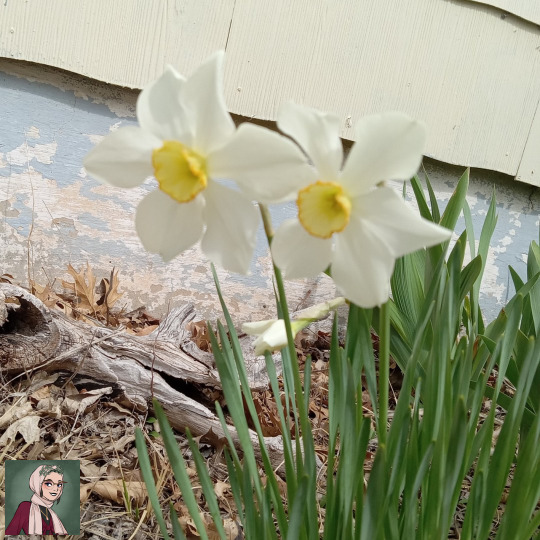
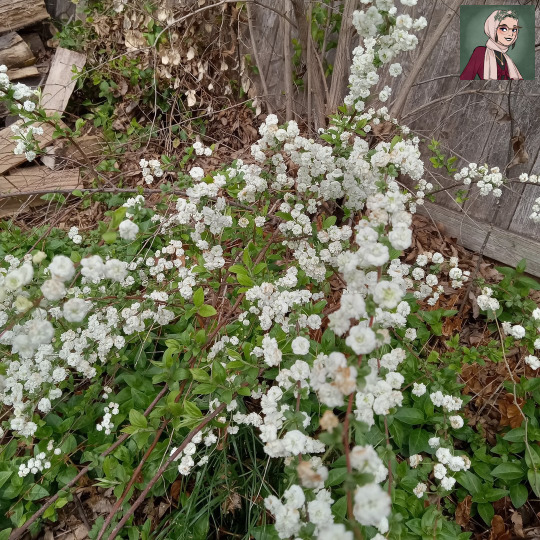
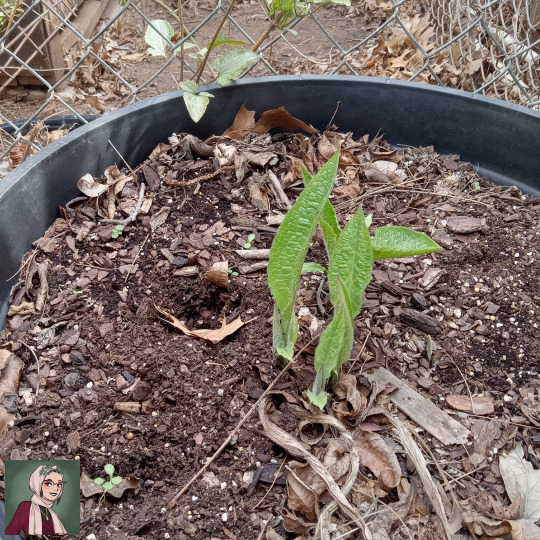
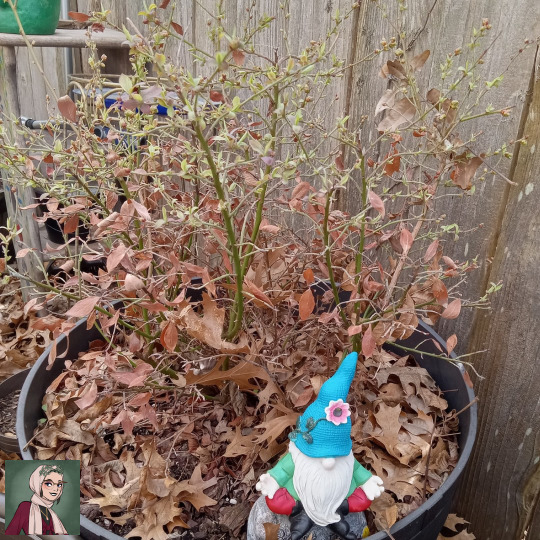


Instagram Repost: March 25, 2023
The garden's going a bit bonkers now that Spring's actually sprung properly. And so when I've had the energy and ability to do so, I've been doing my traditional Walkabouts to see what's coming out finally. Here's what's in the actual garden right now 🌿
Single bloom common yellow Daffodil (Narcissus spp Unknown)
Fun little double bloom Daffodil (Narcissus spp Unknown)
White Tulip (Tulipa Gesneriana cv Unknown)
Some lovely white and yellow single bloom Daffodils (Narcissus spp Unknown)
Bridal-Wreath Spirea (Spiraea Prunifolia)
Common Comfrey (Symphytum Officinale)
Blueberry! (Vaccinium Corymbosum cv 'Bountiful Blue')
Korean Lilac (Syringa Pubescens sbsp. Patula 'Miss Kim')
Chinese Peony (Paeonia Lactiflora; I've been calling it the 'Sorbet' cultivar all these years, but I'm starting to thing that's not actually correct & I transplanted the wrong one- out of two- when we moved!)
Not all of these are in my own garden- only numbers 6 through 9. The rest are my Mother in Laws (except the Bridal-Wreath Spirea, with is a transplant to our yard from the neighbor's, through the fence. We all adore it, though).
#Instagram Reposts#Personal#2023#My Garden#Garden 2023#Gardening#Verderer#Oklahoma#Green Witch#Green Witchcraft#Witchy Gardening#Witches Garden#Witch's Garden#Gardenblr#Plantblr
1 note
·
View note
Photo
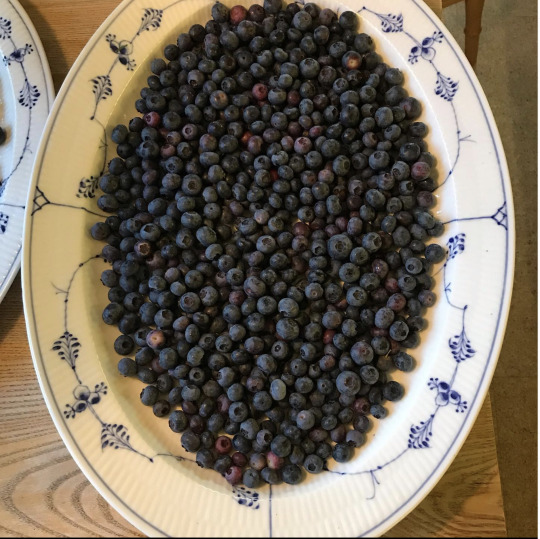
My blueberry (Vaccinium corymbosum) harvest! These beauties are from our own garden bushes, which are domestic blueberries bred from plants native to Canada. Domestic blueberry bushes are taller and yield more berries than their wild relatives, which grow lower to the ground and are therefore not so easy to harvest. The blueberry genus is a cosmopolitan group of species found in the northern regions of Asia, North America, and Europe, as well as in the Andes. The wild blueberries comprise several species and are still harvested as a gourmet food, such as the whortleberries (Vaccinium myrtillus) in the forest ravines of North Devon.
#katia plant scientist#blueberry#blueberries#blueberry harvest#vaccinium#berries#cottagecore#cottage life#harvest#grow your own food#botany#plant facts#oval#royal copenhagen#blue and white
16 notes
·
View notes
Text
This week's curiosity plant is Vaccinium corymbosum, in the ERICACEAE family! Its common name is northern highbush blueberry.
[Research and citations]

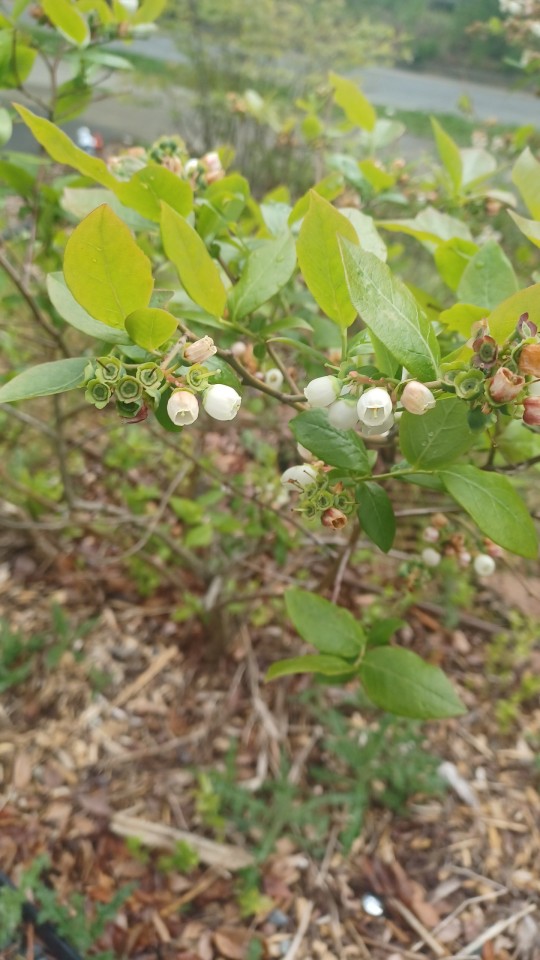
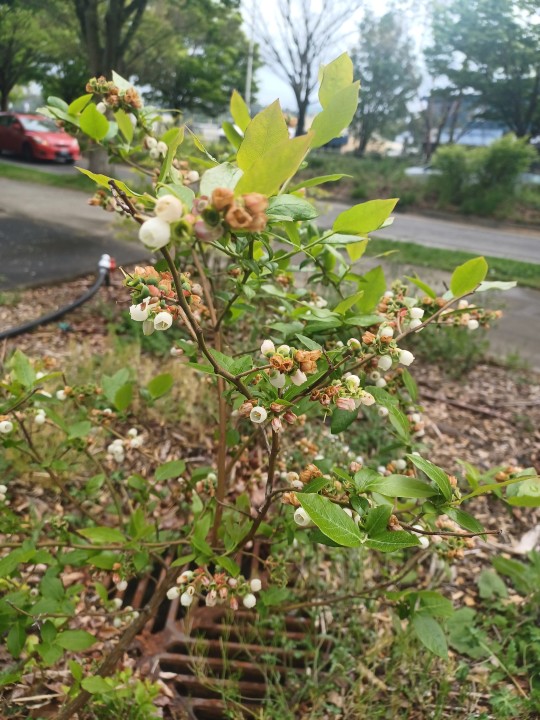
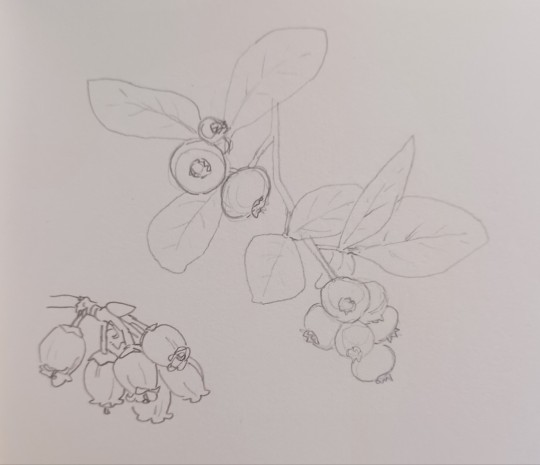
0 notes
Text
Horticulturae, Vol. 10, Pages 192: Exogenous Abscisic Acid Regulates Anthocyanin Biosynthesis and Gene Expression in Blueberry Leaves
Blueberry (Vaccinium corymbosum) leaves have a positive influence on health because of their phenolic contents, including anthocyanins. Phytohormone abscisic acid (ABA) promotes anthocyanin accumulation, but the underlying mechanisms are unclear in blueberry leaves. In this study, we found that exogenous ABA promotes anthocyanin accumulation in blueberry leaves and we explored the global molecular events involved in these physiological changes by treating in vitro-grown blueberry seedlings with ABA and performing transcriptome deep sequencing (#RNA-seq). We identified 6390 differentially expressed genes (DEGs), with 2893 DEGs at 6 h and 4789 at 12 h of ABA treatment compared to the control. Kyoto Encyclopedia of Genes and Genomes (KEGG) pathways related to plant hormone signal transduction and phenylpropanoid and flavonoid biosynthesis were significantly enriched at both stages of the ABA treatment. Analysis of DEGs in plant hormone signal transduction pathways revealed that exogenous ABA affected the expression of genes from other plant hormone signaling pathways, especially brassinosteroid, auxin, and gibberellin signaling. To elucidate the mechanism driving anthocyanin biosynthesis in blueberry in response to ABA treatment, we screened anthocyanin biosynthesis structural genes (ASG) from the phenylpropanoid and flavonoid biosynthetic pathways, MYB transcription factor genes from R2R3-MYB subgroups 5, 6, and 7 and ABRE-binding factor (ABF) genes from the ABA signal transduction pathway. Pearson’s correlation coefficient (r) analysis indicated that the ABFs, MYBs, and structural genes form a network to regulate ABA-induced anthocyanin biosynthesis and MYBA1 is likely to play an important role in this regulatory network. These findings lay the foundation for improving anthocyanin biosynthesis in blueberry leaves. https://www.mdpi.com/2311-7524/10/2/192?utm_source=dlvr.it&utm_medium=tumblr
0 notes
Video
youtube
Highbush blueberry - Vaccinium corymbosum - Huckleberry - borówka ameryk...
0 notes
Note
🔍 :)
//Kaiser's family is all from Unova, but her maternal aunt and her family now live in Galar, and that's where she receives her vast amounts of sweets from. For her own family, she has two younger sisters, called Angie (Vaccinium Angustifolium) and Corrin (Vaccinium Corymbosum). Both are eight, and they write to Kai every single week!
1 note
·
View note
Text
Identité et diversité des pollens collectés par deux espèces d'abeilles pour la pollinisation dans les champs de myrtilles | Environmental Entomology | Oxford Academic
See on Scoop.it - EntomoNews
Identity and diversity of pollens collected by two managed bee species while in blueberry fields for pollination
Kelsey K Graham, Meghan O Milbrath, Michael Killewald, Annuet Soehnlen, Yajun Zhang, Rufus Isaacs Author Notes
Environmental Entomology, nvad072, https://doi.org/10.1093/ee/nvad072
Published:
27 July 2023
[Image] Average percent pollen type per site collected by honey bees and bumble bees in 2018 and 2019. Pollen types other than Vaccinium corymbosum (blueberry) that represented less than 2% of the pollen at each site were grouped into an “other” category. UNId indicated pollen that was not able to be identified. Farms A–H were sampled from in both 2018 and 2019, though only bumble bee collected pollen was sampled from Farm A in 2018.
-------
NDÉ
Traduction
Pour comprendre les besoins et les préférences des abeilles domestiques en matière de pollen pendant la pollinisation des bleuets, nous avons identifié le pollen collecté par les colonies d'Apis mellifera Linnaeus, 1758 (Hymenoptera : Apidae) et de Bombus impatiens Cresson, 1863 (Hymenoptera : Apidae) au cours de deux années. Les bourdons ont collecté une plus grande diversité de pollens que les abeilles mellifères, alors que ces dernières se sont davantage concentrées sur les ressources abondantes. Bien que les myrtilles soient la ressource la plus abondante dans le paysage, elles n'ont pas été le pollen le plus collecté par les deux espèces d'abeilles en 2018. Cependant, c'est le pollen le plus collecté par les bourdons en 2019 et ils ont collecté beaucoup plus de pollen de myrtille que les abeilles mellifères au cours des deux années. En 2018, le nerprun, Rhamnus L. (Rosales : Rhamnaceae) ou Frangula Mill. (Rosales : Rhamnaceae), et de saule, Salix L. (Malpighiales : Salicaceae), ont été abondamment collectés par les deux espèces d'abeilles. En 2019, les pollens de cerisier, Prunus L. (Rosales : Rosaceae), et de saule (Salix) ont été collectés dans des proportions élevées par les deux espèces. Les ronces, Rubus L. (Rosales : Rosaceae), et le trèfle blanc, Trifolium repens L. (Fabales : Fabaceae), étaient également des sources de pollen communes pour les abeilles domestiques, tandis que le chêne, Quercus L. (Fagales : Fagaceae), était récolté par les bourdons. Les analyses de paysage ont également révélé que certains types de couverture terrestre étaient positivement corrélés avec la collecte de types de pollen préférés. Les zones humides herbacées étaient associées à la collecte de pollen de nerprun (Rhamnus/Frangula), de saule (Salix) et de cerisier (Prunus), qui étaient les principales ressources polliniques pour les deux espèces d'abeilles.
Il n'y avait pas de corrélation entre la diversité du paysage et la diversité du pollen, ce qui suggère que les colonies butinent en fonction de leurs besoins nutritionnels plutôt que de la disponibilité des ressources.
0 notes
Text
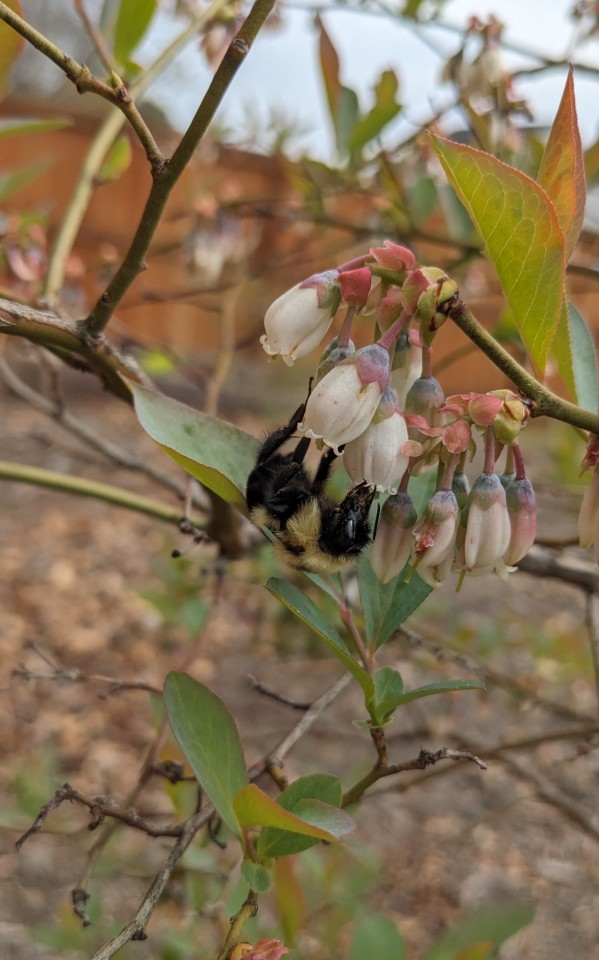
Bombus impatiens on Vaccinium corymbosum / Common Eastern Bumblebee on Northern Highbush Blueberry
#Bombus impatiens#Bombus#apidae#Vaccinium corymbosum#Vaccinium#ericaceae#Common Eastern Bumblebee#bumblebee#bee#Bees#Bumblebees#Northern Highbush blueberry#Highbush blueberry#Blueberry#blueberries#Native pollinators#Pollinators#native insects#Native plants#Native flowers#Flowers#nature photography#photographers on tumblr#Durham#Durham NC#North Carolina#Home#Insects
4 notes
·
View notes
Text
Highbush Blueberries Bloom with Help from Fungal Friends
Highbush Blueberries Bloom with Help from Fungal Friends
https://ift.tt/Iwp6hBD
A blueberry’s ability to attract pollinators might owe something to aid in the soil, according to a study published in the journal PLOS One. O’Neill and colleagues have investigated an intricate web of interactions between plants, fungi, and pollinators that influences the reproductive success of highbush blueberries (Vaccinium corymbosum).
The researchers found that most terrestrial flowering plants, or angiosperms, form relationships with both mycorrhizal fungi – beneficial fungi that boost plant nutrient intake – and animal pollinators. However, the impact of these fungi on pollinator behaviour and plant reproduction remains a mystery for many species. The team sought to clarify this by examining the effects of introducing ericoid mycorrhizal fungi – a specific type of fungi that forms symbiotic relationships with plants – to highbush blueberries.
The findings revealed that plants inoculated with mycorrhizal fungi were more likely to flower and produced more inflorescence buds – clusters of flowers – compared to non-inoculated plants. Interestingly, this effect was especially strong when the fungi were sourced from local soil rather than a commercial inoculant. This suggests that local mycorrhizal fungi might be better adapted to interact with the local plant species.
It’s important to note that while the fungi increased flowering, they didn’t directly affect fruit set (the proportion of flowers that turn into fruit) or fruit sugar content. The study also found that increased flower production didn’t necessarily translate into more pollinator visits. O’Neill and colleagues write:
Our results add to the growing evidence that plant interactions with belowground organisms can affect those aboveground. In addition, our results demonstrate that the outcome of the interactions can depend on identity of the fungal partners, the match between fungi and host, and interactions beyond plant host and mycorrhizal fungi such as those with pollinators and plant diseases. The complexity of these interactions challenges generalization and points to the need for greater study at scales that range from molecular mechanisms to functional traits within hosts and fungi, to effects that can only be elucidated in communities and ecosystems.
O’Neill et al. 2023
This research reveals the intricate relationships between plants, fungi, and pollinators and underlines the need for a better understanding of these interactions to enhance plant reproduction, particularly for crops like highbush blueberries. As a consumer, improved agricultural practices could result in more abundant, sustainable crops, which could impact your grocery shopping in terms of availability and price.
READ THE ARTICLE
O’Neill, E., Brody, A.K. and Ricketts, T. (2023) “Inoculum source dependent effects of ericoid, mycorrhizal fungi on flowering and reproductive success in highbush blueberry (Vaccinium corymbosum),” PLOS One, 18(4), p. e0284631. Available at: https://doi.org/10.1371/journal.pone.0284631.
The post Highbush Blueberries Bloom with Help from Fungal Friends appeared first on Botany One.
via Botany One https://botany.one/
July 04, 2023 at 09:00AM
0 notes
Text
youtube
June garden in Pennsylvania , Planting blueberry bushes and starting more seeds
June garden update in Pennsylvania Planting blueberry bushes and starting more seeds
Vaccinium corymbosum
North American species the Northern highbush blueberry .
Hanna Freeman Bean
Native american pole bean
If interested in the seeds the link below
Hannah Freeman Bean – Truelove Seeds https://trueloveseeds.com/products/ha...
If you want to learn more about the Hanna Freeman Bean check out my other video here Hanna Freeman Bean - YouTube
Hanna Freeman Bean - YouTube
#youtube#plants#garden#native plants#biodiversity#nature#pennsylvania#greenthumb#gardening#gardners#native american#heirloom seeds#seeds
0 notes
Link
mirtillo Americano Generalità Il mirtillo americano (Vaccinium corymbosum) è un arbusto perenne appartenente alla famiglia delle Ericaceae. È originario
0 notes